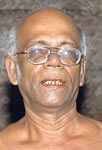Veteran clay craftsman P. Wilson Wijesinghe, and his three sons were putting the finishing touches to their unique clay lantern at Biyagama. Fashioned entirely of clay, the giant set of lanterns stood 24 feet high and 20 feet wide. The six-tiered central section depicts the typical ‘Walankadha’ taken by vendors on the roads in old times, explained Wijesinghe.
 |
| Creation in clay |
The base is the clay cooker, above which are placed the traditional cooking pots in tiers. On the cooker is the ‘Muttiya’, for cooking rice, topped by the ‘Nembiliya’, used to clean the rice, then come the ‘Kalaya’ or water pot, the ‘Athiliya’, a shallow pot for cooking curries and finally the cover. Extending from the central section are eight arms at two levels. Each arm carries a cluster of smaller ‘kalayas’. There is a total of 375 small pots in the clusters. All the pots are perforated and fitted with coloured electric lights.
At the flick of a switch, the entire contraption rotates and the lights twinkle through the perforations.
And that is not all. Arranged in about 12 sections round the lanterns are beautifully carved, lifelike clay figures which relate the Jataka tale of ‘Angulimala’. The Wijesinghe family was working round the clock to complete their creation in time for the Vesak Festival on May 27.
The lanterns are enclosed in a huge tent of canvas and rubberised sheeting. “This is a dream of my father’s,” says Prabath, the eldest son. He has watched the story on CD and recorded the relevant sections, relating the story in dialogue form, which will be played alongside the exhibit. Prabath added that they plan to transform the area round the lanterns into a jungle scene to go with the story.
Wilson Wijesinghe says his family has been engaged in traditional clay craft for generations. His father was Henrick Gurunnanse of Kegalle, while his grandfather was John Wijesinghe. His father initiated the training course for young craftspeople in Molagoda, Kegalle. Wijesinghe too followed in his father’s footsteps in conducting the training course, until he moved to Biyagama after his marriage 40 years ago. He now conducts training courses for young boys of the area.
The veteran craftsman said he first started making the clay lanterns in 1993, when he made a small clay ‘pahan kooduwa’ of about four feet in height. For the first three years he exhibited his lantern free of charge, Gradually as he developed it into a larger exhibit he started charging a small fee. This lantern is his 16th exhibit, he said. He did not make it for the last four years because of the war situation.
 |
| Wijesinghe |
According to Wijesinghe, he has spent about Rs. 750,000 on the lanterns, using 3 ½ tons of clay and 4,800 light bulbs.
The site, where the lantern is erected, is on the main Biyagama road, just past the bridge, and cost Rs. 100,000 to rent. “We transported the clay from Polonnaruwa, Kegalle and Biyagama by lorry,” he added. “It took us three months to make it, with 17 people working full time on it. My three sons Prabath, Nishantha and Shiroman are all following our ancestral craft and they help me.”
The Wijesinghes have a shop in Biyagama, Bandarawatte, where they market a wide range of clay items.
This year he is charging an entrance fee of Rs. 40 for adults and Rs. 20 for children to recover some part of the cost. The last time he exhibited his work, he lost about Rs. 600,000 due to a fire that broke out. This time they are not using cadjan for the roof.
Wijesinghe plans to exhibit the giant lantern until June 7. Thereafter, they will reopen for Poson with some small changes. “Several people have asked to purchase parts of the lantern to exhibit in various places,” Wijesinghe said. “If we get a sponsor to take it to somewhere like Hambantota or Kataragama for the Esala festival we would like to do it,” added Prabath, “as there will not be sufficient time to move it before Poson.” |



